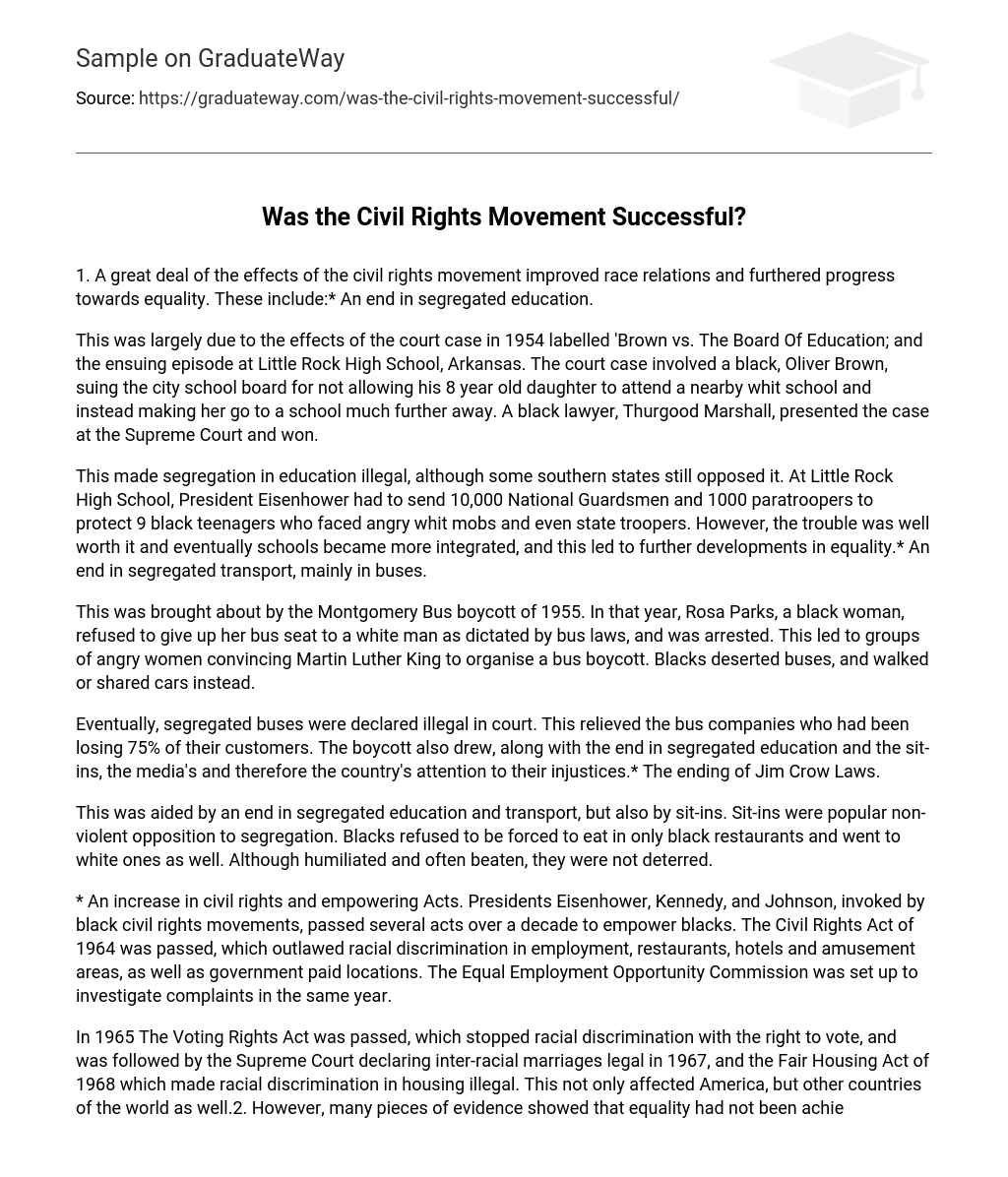1. A great deal of the effects of the civil rights movement improved race relations and furthered progress towards equality. These include:* An end in segregated education.
This was largely due to the effects of the court case in 1954 labelled ‘Brown vs. The Board Of Education; and the ensuing episode at Little Rock High School, Arkansas. The court case involved a black, Oliver Brown, suing the city school board for not allowing his 8 year old daughter to attend a nearby whit school and instead making her go to a school much further away. A black lawyer, Thurgood Marshall, presented the case at the Supreme Court and won.
This made segregation in education illegal, although some southern states still opposed it. At Little Rock High School, President Eisenhower had to send 10,000 National Guardsmen and 1000 paratroopers to protect 9 black teenagers who faced angry whit mobs and even state troopers. However, the trouble was well worth it and eventually schools became more integrated, and this led to further developments in equality.* An end in segregated transport, mainly in buses.
This was brought about by the Montgomery Bus boycott of 1955. In that year, Rosa Parks, a black woman, refused to give up her bus seat to a white man as dictated by bus laws, and was arrested. This led to groups of angry women convincing Martin Luther King to organise a bus boycott. Blacks deserted buses, and walked or shared cars instead.
Eventually, segregated buses were declared illegal in court. This relieved the bus companies who had been losing 75% of their customers. The boycott also drew, along with the end in segregated education and the sit-ins, the media’s and therefore the country’s attention to their injustices.* The ending of Jim Crow Laws.
This was aided by an end in segregated education and transport, but also by sit-ins. Sit-ins were popular non-violent opposition to segregation. Blacks refused to be forced to eat in only black restaurants and went to white ones as well. Although humiliated and often beaten, they were not deterred.
* An increase in civil rights and empowering Acts. Presidents Eisenhower, Kennedy, and Johnson, invoked by black civil rights movements, passed several acts over a decade to empower blacks. The Civil Rights Act of 1964 was passed, which outlawed racial discrimination in employment, restaurants, hotels and amusement areas, as well as government paid locations. The Equal Employment Opportunity Commission was set up to investigate complaints in the same year.
In 1965 The Voting Rights Act was passed, which stopped racial discrimination with the right to vote, and was followed by the Supreme Court declaring inter-racial marriages legal in 1967, and the Fair Housing Act of 1968 which made racial discrimination in housing illegal. This not only affected America, but other countries of the world as well.2. However, many pieces of evidence showed that equality had not been achieved, and that it would take a long time for people to change their morals :* There were a large number of violent race riots in the mid 1960s in America’s major cities.
In August 1965, the black ghetto in Watts, Los Angeles, erupted in violence sparked off by white police officers roughly treating some blacks. Thirty four were killed, hundreds injured, and thousands injured. In 1967, in Detroit and Newark as well as other cities, there came the worst riots in American history. 83 people were shot dead.
The conclusion for the cause was that ‘white racism was chiefly responsible for the explosive mixture of poverty, discrimination and anger in the black community.’* King was assassinated. In 1968, he travelled to Memphis in support of a strike by black refuse collectors. As he stood on the balcony of the Lorraine Motel he was shot dead by a man with a rifle across the street.
A man called James Earl Ray was later arrested, and was widely believed to be a hired killer for King’s enemies. This showcases the number of enemies against King in particular and blacks in general.* Blacks still faced hardships and discrimination. Even now, one third of black Americans struggle to survive below the poverty level, compared to 10% of whites.
Urban poverty in particular represents a continuing and worsening problem and remains disproportionately high among blacks. High school graduation rates are still low compared to whites, as are employment figures, household income and the number of black elected officials. Even in 1992, blacks still filed 49,000 cases of discrimination complaints.3.
I believe that the reasons to take an optimistic view of the black civil rights movement’s success outweigh the reasons to take a pessimistic view, not only in quantity but also in their worth. Although, as mentioned above, blacks still face discrimination, their lives have improved, and are improving, tremendously. People are taught more than ever today that there is no difference due to skin colour, and the whole mindset towards blacks has changed both in American and international communities. Although full equality has not yet been reached, the civil rights movement did put fundamental reforms in place.
Legal segregation as a system of racial control was dismantled, and blacks were no longer subject to the humiliation of Jim Crow laws. Public institutions were opened to all. Blacks achieved the right to vote and the influence that went with that right in a democracy. But what I believe is the most important of all is the effect of this on other countries’ racial systems, particularly South Africa.
It was America’s successes that led to the end of the policy of apartheid, and that, along with the points above, is indeed a long step towards racial equality.





